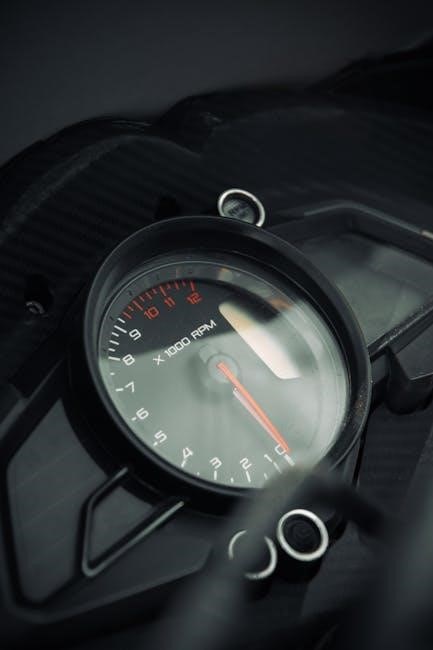Sanding carbon fiber requires precision and patience to achieve a smooth, high-quality finish․ It involves progressive grits, from coarse to fine, ensuring proper surface preparation and polishing․ Always use appropriate PPE to protect against dust and debris․
Understanding the Importance of Sanding in Carbon Fiber Work
Sanding is a critical step in carbon fiber work, ensuring surfaces are level, smooth, and properly prepared for coatings or resins․ It removes imperfections, such as uneven layers or debris, and creates a strong bond between layers․ Proper sanding prevents damage to the carbon fiber weave and enhances the material’s strength and aesthetic appeal․ Using progressively finer grits achieves a high-gloss finish, making sanding essential for both functional and visual quality in carbon fiber projects․

Preparing Your Workspace
Create a clean, dust-free workspace to ensure efficient sanding․ Organize tools and materials, and use a vacuum to minimize debris for optimal results․
Setting Up a Clean and Dust-Free Environment
Creating a clean workspace is crucial for effective carbon fiber sanding․ Dust and debris can compromise the finish, so use a vacuum with a HEPA filter to remove particles․ Cover your work surface with a drop cloth or plastic sheet to contain dust․ Ensure good ventilation to prevent inhaling fine carbon fibers․ Organize tools and materials within easy reach to maintain efficiency․ Regularly wipe down surfaces with a damp cloth to minimize static, which can attract dust․ A well-prepared environment ensures better results and safer working conditions․
Essential Tools and Materials for Sanding Carbon Fiber
Essential tools include various grit sandpapers, sanding discs, dual-action sanders, and sanding blocks․ Polishing compounds are crucial for achieving a high-gloss finish․ Use water or a lubricant to prevent sandpaper clogging․ Personal protective equipment, such as masks and gloves, is a must․ A vacuum system or HEPA filter helps manage dust․ These tools ensure efficiency, safety, and a professional-quality result․ Always have a clean workspace and organize materials to streamline the sanding process․ Proper tools are key to avoiding damage and achieving the desired finish․

Selecting the Right Sandpaper Grits
Start with coarse grits (60-100) for surface preparation, then progress to medium grits (320-400) for smoothing, and finish with extra-fine grits (1000-1200) for polishing․
Starting with Coarse Grits (60-100 Grit) for Surface Preparation
Begin sanding with coarse grits (60-100) to remove imperfections and roughen the surface․ Use even pressure and maintain a consistent angle to avoid unevenness․ This step ensures a strong bond for new carbon fiber layers․ Work carefully around edges to create a level base․ Sanding at this stage is crucial for proper adhesion and a smooth finish; Always wear PPE to protect against dust, and avoid excessive force to prevent damage․ Progress methodically to finer grits for optimal results․
Progressing to Fine Grits (320-400 Grit) for Smoothing
After initial sanding, switch to fine grits (320-400) to smooth the carbon fiber surface․ Use light, even strokes, maintaining consistent pressure to avoid creating scratches․ Wet sanding is recommended to prevent dust buildup and improve results․ This step refines the surface, preparing it for polishing․ Work methodically, ensuring no areas are over-sanded․ Always wear PPE to protect against fine particles․ The goal is a uniform, glossy appearance, setting the foundation for a flawless finish․ Avoid skipping this step, as it ensures proper surface preparation for further processing․
Final Touch with Extra-Fine Grits (1000-1200 Grit) for Polishing
Using extra-fine grits (1000-1200), achieve a polished finish by gently sanding in a circular motion․ This step removes minor imperfections, enhancing the carbon fiber’s natural sheen․ Wet sanding is crucial to prevent scratching and ensure even results․ Work carefully, avoiding excessive pressure that could damage the material․ The outcome is a mirror-like surface, ready for resin or coatings․ This final step requires attention to detail to maintain the integrity and visual appeal of the carbon fiber․

Safety Precautions
Always wear PPE, including gloves, safety glasses, and a dust mask․ Carbon fiber dust can cause skin irritation and respiratory issues․ Ensure proper ventilation and avoid inhaling fine particles during sanding․ Keep the workspace clean to minimize dust accumulation and prevent potential health risks․ Regularly clean tools and surfaces to maintain a safe working environment․
Wearing Personal Protective Equipment (PPE)
Protecting yourself is crucial when sanding carbon fiber․ Always wear gloves to prevent skin irritation and cuts․ Safety glasses or goggles are essential to shield your eyes from flying debris․ A dust mask or respirator is vital to avoid inhaling harmful carbon fiber particles․ Coveralls or a long-sleeved shirt can protect your skin from dust․ Ensure all PPE fits properly to maximize protection․ Proper ventilation in your workspace is also necessary to reduce dust circulation․ Never sand without PPE, as carbon fiber dust can cause serious respiratory and skin issues․ Prioritize your safety throughout the process․
Managing Carbon Fiber Dust and Debris
Carbon fiber dust is highly hazardous, requiring careful management․ Use a vacuum with a HEPA filter to capture fine particles during sanding․ Avoid sweeping with a brush, as it spreads dust․ Dampen surfaces with water to minimize airborne particles․ Contain the workspace with plastic sheets to prevent dust spread․ Dispose of waste in sealed containers․ Regularly clean tools and equipment to remove residue․ Proper ventilation and air filtration systems are essential to maintain a safe environment․ Effectively managing dust ensures a cleaner workspace and reduces health risks associated with carbon fiber particles․

The Sanding Process
Start with coarse grits to level the surface, then progress to finer grits for smoothing․ Use even pressure and consistent angles to avoid damaging the carbon fiber․
Initial Sanding: Creating a Level Surface
Begin with a 60- to 100-grit sandpaper to roughen the surface, ensuring even pressure and consistent angles․ This step removes imperfections and prepares the carbon fiber for subsequent finer grits․ Avoid excessive force to prevent damage․ Work methodically, especially around edges, to maintain a level surface․ Always sand with the weave to avoid fraying the fibers․ This foundational step is crucial for achieving a smooth, even base for further refinement and polishing․
Refining the Surface: Achieving a High-Gloss Finish
After initial sanding, progress to finer grits (320-400) to smooth the surface․ Use consistent, light pressure and sand with the carbon fiber weave to avoid damage․ Wet sanding with soapy water helps prevent dust buildup and improves results․ For a mirror-like finish, transition to extra-fine grits (1000-1200) and finish with polishing compounds․ Avoid applying too much pressure, which can create scratches or unevenness․ This step requires patience and attention to detail to achieve a pristine, high-gloss surface that highlights the carbon fiber’s natural beauty and durability․
Surface Preparation for Finishing
After sanding, abrade the surface with 120-grit sandpaper to create a mechanical grip for resin or coatings․ Ensure the surface is clean, dry, and free of dust before applying finishes․
Applying Resin or Coatings After Sanding
After sanding, clean the surface thoroughly to remove dust and debris․ Apply resin or coatings evenly, following the manufacturer’s instructions․ Use a brush or roller for smooth application․ Ensure the surface is dry and free of contaminants for proper adhesion․ Allow the resin to cure completely before proceeding to the next step․ This step is critical for achieving a durable and professional-looking finish․ Always follow safety guidelines when handling resins and coatings to avoid complications․

Polishing and Finishing
Polishing enhances the carbon fiber’s appearance, achieving a high-gloss finish․ Use polishing compounds and buffing wheels to remove minor scratches and imperfections, ensuring a mirror-like surface․
Using Polishing Compounds for a Mirror-Like Finish
Polishing compounds are essential for achieving a pristine, mirror-like finish on carbon fiber․ Apply a high-quality polishing compound using a clean, soft buffing wheel․ Work in small, controlled circular motions, maintaining consistent pressure․ Avoid over-polishing, as this can damage the surface․ Gradually increase the compound’s fineness for optimal results․ Use a clean microfiber cloth to wipe away excess compound and inspect the surface under bright light for any remaining imperfections․ This step ensures a flawless, reflective finish, enhancing the carbon fiber’s natural beauty and durability․

Tips and Tricks
Use wet sanding to prevent paper clogging and achieve smoother results․ Avoid excessive pressure to prevent damaging the carbon fiber weave․ Inspect the surface under bright light after each grit progression to ensure even sanding․ Never skip grits, as this can leave scratches․ Work in small, controlled motions for consistency․ Keep the workspace clean to avoid contamination․ Use high-quality polishing compounds for the final finish․ Always maintain sharp tools to avoid tearing the material․ Regularly clean your sanding tools to ensure optimal performance․ Stay patient and methodical for the best outcome․
Avoiding Common Mistakes in Carbon Fiber Sanding
Avoid applying excessive force, which can damage the carbon fiber weave․ Never skip grits, as this may leave deep scratches․ Use wet sanding to prevent dust buildup and clogging․ Maintain consistent angles and pressure to ensure even results․ Avoid sanding in high-speed settings, as it can generate excessive heat․ Keep the workspace clean to prevent contamination․ Regularly inspect the surface under bright light to detect imperfections early․ Avoid using dull sandpaper, as it can tear the material․ Always clean sanding tools to maintain efficiency․ By following these tips, you can achieve a flawless finish and avoid costly repairs․
Successful carbon fiber sanding requires patience, precision, and adherence to proper techniques․ A well-sanded surface ensures durability and enhances the material’s aesthetic appeal, making it professional-grade․
Final Inspection and Quality Control
The final inspection ensures a flawless finish by examining the surface under bright light for scratches or dust․ Verify the surface is even, with no imperfections, and properly prepared for coatings․ Quality control involves checking for consistency and adherence to standards, ensuring durability and visual appeal․ Use gauges or visual checks to confirm smoothness and proper layer alignment․ Addressing any issues now prevents future problems like peeling or uneven finishes․ This step is critical for achieving professional-grade results and maintaining the integrity of the carbon fiber material․
